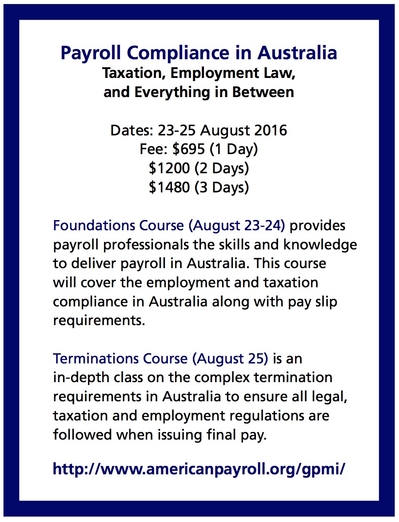An expert in Australian payroll explained the similarities and the many differences between Australian and U.S. payroll during the American Payroll Association’s (APA’s) Global Payroll Management Forum in Nashville, Tennessee, in May.
Jason Low, Senior Payroll SME of Australia’s The Association for Payroll Specialists (TAPS), discussed Australia’s National Employment Standards, 10 minimum standards for employees that cover everyone in the national workplace relations system. He continued with an informative overview of awards, superannuation, and taxation, providing ample time for questions and answers along the way.
 National Employment Standards
National Employment Standards
Australia’s 10 National Employment Standards are:
- Maximum weekly hours
- Requests for flexible working arrangements
- Parental leave and related entitlements
- Annual leave
- Personal carers leave and compassionate leave
- Community service leave
- Long service leave
- Public holidays
- Notice of termination and redundancy pay
- Fair Work Information Statement
Low went into useful detail, drilling down to provide a clear understanding of each area and employer responsibilities.
Awards
Because nothing in payroll is as simple as it might first appear, the next category that Low discussed is called awards.
“Awards are defined in a legal document that sets out over 122 different minimum terms and conditions of employment for employees in a particular industry or occupation,” Low said.
It’s particularly important to understand awards because they apply to 122 different areas, such as clerks (private sector), airport employees, fast food, and hair and beauty. A single industry, such as printing, may be covered by a number of different awards based on the types of employees, such as those engaged in printing, sales, reception and administrative, and truck delivery drivers, Low explained.
“The restaurant industry Award has 24 classifications across 13 employment types, which means that there are 312 different rates of pay,” he said in presenting one of many “fun facts’ in his presentation.
After providing background on the Australian legislative process, Low introduced his audience to Australian taxation—noting that only federal income tax is withheld. The key identifier, a person’s personal tax file number (TFN) is a tightly held piece of information. Unlike in the United States, where one’s social security number is used for various types of identification, in Australia, the employer’s job is to ensure privacy.
What’s Super?
Another area of discussion of interest to payroll professionals is superannuation, or ”super.” Super is a special way of saving toward retirement through one’s employment. The employer contribution to an employee’s superannuation fund is a legal requirement, and some choose to voluntarily exceed these minimum requirements. Details on super and understanding ordinary time earnings can be found in Superannuation Guarantee Ruling (SGR) 2009/2, on the Australian Tax Office website.
 U.S. to Grow to Australia
U.S. to Grow to Australia
Low covered many topics in his 90-minute workshop, but it quickly became clear that his upcoming three-day workshop at APA’s MEET Las Vegas location will provide added value.
At the Global Payroll Management Forum, Low’s overview included a discussion on payroll tax, an employer-paid state tax for which the rules vary from state to state. Australia is divided into six states and two territories, and its capital is Canberra.
If you’re not yet involved in payroll in Australia, you may well be at some point in the future. The number of U.S.-based companies operating in Australia is bound to grow. A provision in Australia’s 2016-17 budget released May 3, 2016, would cut the current 30% corporate tax rate to 25% for all businesses by 2026-27. This proposal to cut the corporate tax rate will benefit the U.S. government the most because of existing double taxation agreements that would boost U.S. tax revenues, according to a study by the Australia Institute. The United States is the largest foreign investor in Australia, accounting for 27% of all foreign investment.
In Australia, employers are starting to specifically request payroll qualifications as part of their recruitment process, from a Certificate IV in Payroll Administration to a diploma of Payroll Management. Low’s workshop will help to increase your knowledge base so you can know what questions to ask.